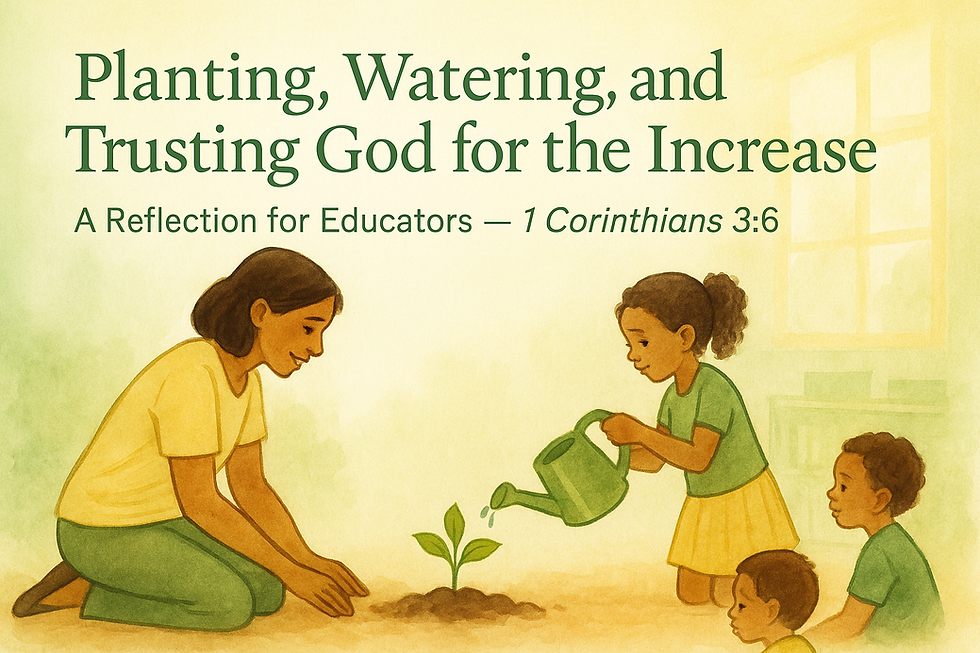Turning Observations into Action: Using Developmental Information to Guide Programme Planning
- Natasha Francis-Campbell
- Sep 17
- 3 min read
In early childhood education, observing and recording children’s progress is only the first step. The real transformation happens when teachers take that information and use it to plan meaningful programmes that nurture every child’s growth. Here’s how we can move from simply collecting notes to building intentional learning experiences that foster development.
1. Analyse the Information Collected
It’s not enough to write down what we see. We must go back and study the notes, checklists, and portfolios. Patterns will begin to emerge: perhaps several children are excelling in art, while others are struggling with speech clarity. By analysing data, we identify both strengths and areas for improvement, giving us a clearer picture of the whole child.
2. Set Developmental Goals
Once the information is reviewed, it’s time to set goals. These goals should be SMART (Specific, Measurable, Achievable, Relevant, Time-bound). For example:
Individual Goal: “By the end of the term, Sarah will be able to use scissors to cut along a straight line with minimal support.”
Group Goal: “The class will practise turn-taking games to strengthen social skills.”
Clear goals guide us in choosing the right activities and tracking progress effectively.
3. Adapt the Curriculum and Activities
Information gathered should flow directly into our daily and weekly plans. If children show strong interest in music, we weave in more singing, rhythm, and instrument play. If fine motor development is an area of need, we introduce threading beads, puzzles, and playdough activities. Adapting the curriculum ensures relevance and engagement, while addressing specific developmental needs.
4. Differentiate Instruction
Every classroom has children at different developmental stages. Using collected information allows us to differentiate learning so no one is left behind. For example:
Children who need support may work on simplified tasks with extra guidance.
Children who are advanced may be given extended challenges to stretch their skills.
Differentiation honours individual growth while maintaining inclusion.
5. Create Individualised Support Plans
Some children need more than general adaptation. Developmental records help us know when to design an Individual Education Plan (IEP) or tailored interventions. For instance, if a child shows consistent speech delays, targeted activities like picture card games and sound recognition exercises can be introduced. Where necessary, collaboration with specialists ensures that support is timely and effective.
6. Inform Daily Routines and Environment Setup
Developmental information is not only for lesson planning — it also guides how we structure the classroom. If children need more movement, we plan additional outdoor play. If transitions are challenging, we add predictable cues like songs, countdowns, or visual charts. Even the arrangement of learning centres can be adjusted to promote independence and reduce frustration.
7. Strengthen Parent and Community Partnerships
Parents are our strongest partners in fostering development. Sharing observation results and progress updates invites them into the journey. When parents understand their child’s needs, they can reinforce skills at home through simple activities — like reading together, sorting laundry for classification, or practising fine motor tasks. This home-school partnership builds consistency and helps children thrive.
8. Evaluate and Reflect
Finally, the process must come full circle. After implementing strategies, we return to observe, record, and reflect again. Did the child improve? Are new needs emerging? Did our activities meet the intended goals? Regular reflection allows us to refine our approaches, ensuring continuous growth for both children and educators.
Finally
Collecting information on children’s development is only powerful when it leads to action. When teachers analyse, plan, adapt, and reflect, they create learning environments where every child can discover their strengths, overcome challenges, and reach their God-given potential.
Let’s shift the culture. Share the blog with a colleague.



Comments